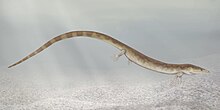Urocordylidae
| Urocordylidae Temporal range:
Late Carboniferous | |
|---|---|

| |
| Life restoration of Sauropleura pectinata
| |
| Scientific classification | |
| Domain: | Eukaryota |
| Kingdom: | Animalia |
| Phylum: | Chordata |
| Clade: | Sarcopterygii |
| Clade: | Tetrapodomorpha |
| Order: | †Nectridea |
| Family: | †Urocordylidae Lydekker, 1889 |
| Subfamilies | |
The Urocordylidae are an
Fossils have been found from Ireland, France, and the eastern United States. The family was named by English naturalist Richard Lydekker in 1889 and includes the well-known genera Urocordylus and Sauropleura, as well as several others based on less-complete material.[2] The family Urocordylidae is divided into two subfamilies, the Urocordylinae and the Sauropleurinae. The two groups are distinguished by the shapes of their skulls; urocordylines have short, blunt skulls, and sauropleurines have longer, pointed skulls.[3]
Description
Urocordylids are distinguished by their elongated tails. Each tail vertebra has an upper crest of bone called a
Another distinguishing feature of urocordylids is the loose connection between the bones of the skull. The bones at the back of the lower jaw do not connect with the rest of the skull. Instead, a gap extends across the skull and closes in front of the eye sockets. This allows the upper jaw to flex upward, increasing the gape of the mouth. The bones at the back of the jaw may also be able to flex outward.[4] The flexibility of the jaws of urocordylids may have been an adaptation for feeding, allowing sharp teeth at the tip of the jaw to face outward so prey could be more easily captured.[1]
Relationships
Urocordylids belong to a large group of
|
References
- ^ ISBN 978-3-931516-26-0.
- ^ PMID 12803423.
- ^ .
- ^ a b c Carroll, R.L. (2009). "The Radiation of Carboniferous Amphibians". The Rise of Amphibians: 365 Million Years of Evolution. Baltimore: Johns Hopkins University Press. pp. 61–143.
